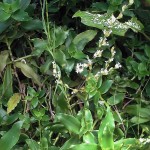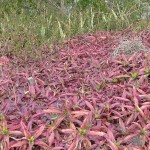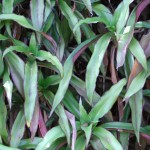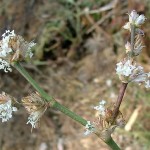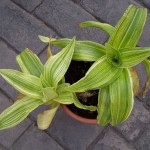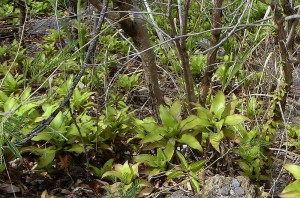Family: Commelinaceae
Synonymous: Spironema orthandrum
Rectanthera fragrans
Spironema fragrans
Distribution and habitat: Callisia fragrans is endemic to Mexico and naturalized in the West Indies, scattered locations in the United States, and a few other places.
Callisia fragrans is a long-lived creeping herbaceous plant with leaves crowded into rosette-like clusters and spreading laterally via long runners. It occurs in pinelands, hammocks and disturbed areas.
Description: Callisia fragrans is a sprawling plant. It has elliptic, pointed leaves up to 25cm (10 inch) long and 5cm (2 inch) wide carried on fleshy stems up to 90cm (35 inch) long. The fresh, glossy green leaves tend to become reddish purple in strong light. In young plants the short teams are arranged in a rosette-like shape, but they rapidly lengthen. The occasional flowers are white and fragrant, clustered towards the tips of long flowering stems. Individual flowers are almost stalkless with three elongated petals, short-lived that wilt at noon. The fruit are small, three-celled, capsules.
Houseplant care: Callisia fragrans is very hardy and may able to take much abuse as overwatering or neglect of watering. It is odd-looking plant and grows fast. Provide ample room for this big, spreading plant.
Light: Give Callisia fragrans bright light including about three or four hours a day of direct sunlight at all times.
Temperature: Callisia fragrans thrive in warm rooms. It is advisable, however, to give them a short winter rest period at 10-16C (50-61F), if possible.
Watering: During the active rest period water plentifully, enough to keep the potting mixture thoroughly moist, but never allow pots to stand in water. In rest period water sparingly, giving enough to make the potting mixture barely moist and allow the top two-thirds to dry out between waterings.
Feeding: Use standard liquid fertiliser once every two weeks in the active growth period only.
Potting and repotting: Use either soil-based or peat-based potting mixture. Callisia fragrans grows fast and needs repotting every spring; large specimens may require 12 or 15cm (5-6 inch) pots. If a plant begins to lose its lower leaves it should be replaced.
Gardening: Callisia fragrans flourishes in warm subtropical climates but can tolerate a mild frost.
Pinch plants frequently to encourage branching and prevent long, scraggly growth.
Position: Callisia fragrans can be planted in part sun to shade. If grown in shade the plants are full and compact; in sun the leaves color more brightly.
Soil: The substrate for Callisia fragrans should be gritty loam. It grows well in fertile soils.
Irrigation: Callisia fragrans prefers moist soil, but once established will tolerate extensive drought. When watered this plant can get of good size. If no rain, water regularly every 1-2 weeks, moistening the soil thoroughly. Allow the soil to dry completely before watering again and do not allow plants to stand in water. During the winter rest period, stop watering.
Expect this plants to shed their leaves while getting established.
Fertilisation: For healthy growth use a fertiliser for flowering plants which can be added to the irrigating water, every 20-25 days. Alternatively, sprinkle the plants with a slow release fertiliser every 3-4 months.
Propagation: Take 5cm long tip cuttings in spring or summer. Insert one cutting of Callisia fragrans in a 5 or 8cm pot of standard potting mixture, and keep in bright filtered light, watering sparingly. After two or three weeks, when the new roots have developed, treat them as mature Callisia fragrans.
Recommended varieties:
Callisia fragrans cv. 'Melnikoff' have lengthwise white or cream coloured stripes of different widths.
Availability: Callisia fragrans is often sold bareroot tips which have already aerial roots formed. They will root readily and grow quickly. Alternatively, buy Callisia fragrans seed or palnted in pots or hanging baskets from specialised nurseries.
Note: Callisia fragrans is a known weed in subtropical gardens where forms a dense spreading ground-cover that can rapidly overtake bushland areas. It therefore has the potential to crowd out native species and prevent their regeneration. It becomes extremely aggressive and dominant in the places where it is found.
Uses and display: Callisia fragrans can be used decoratively in many ways: as edgers in hanging baskets, urns and window boxes spillover; as a groundcover beneath Zingiber (Gingers), Musa (Bananas) species and other taller tropicals; or to fill bare spots in the garden. It suits tropical designs.
SUMMARY:
CHARACTERISTICS:
Foliage green
Shape climbing and trailing
Height: 15-30cm (6-12 inch)
Spread: 1.2-1.8mcm (4-6 feet)
PROPER CARE:
Watering in rest period sparingly
Watering in active growth period plentifully
Light bright
Temperature in rest period min 10C max 16C (50-61F)
Temperature in active growth period min 16C max 21C (61-70F)
Humidity low
Hardiness zone: 10b-11
